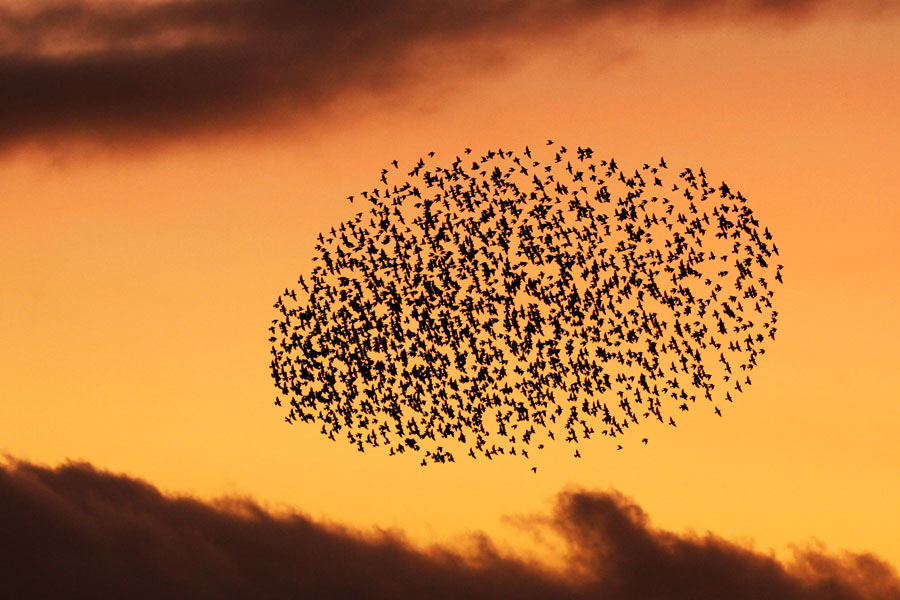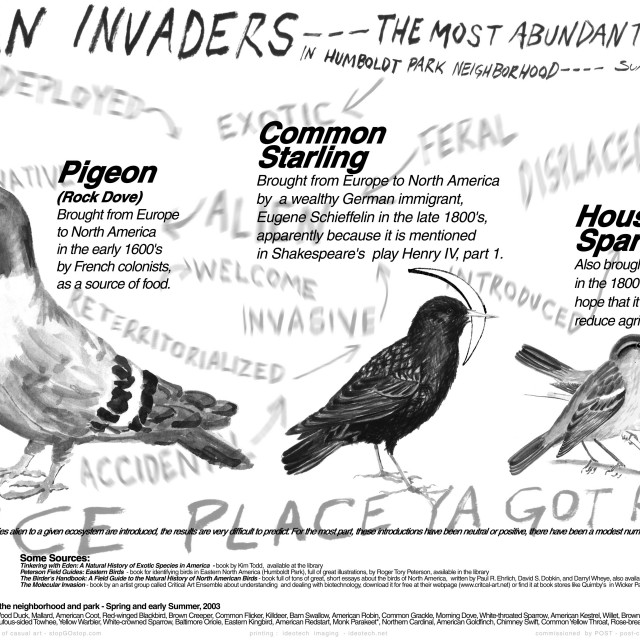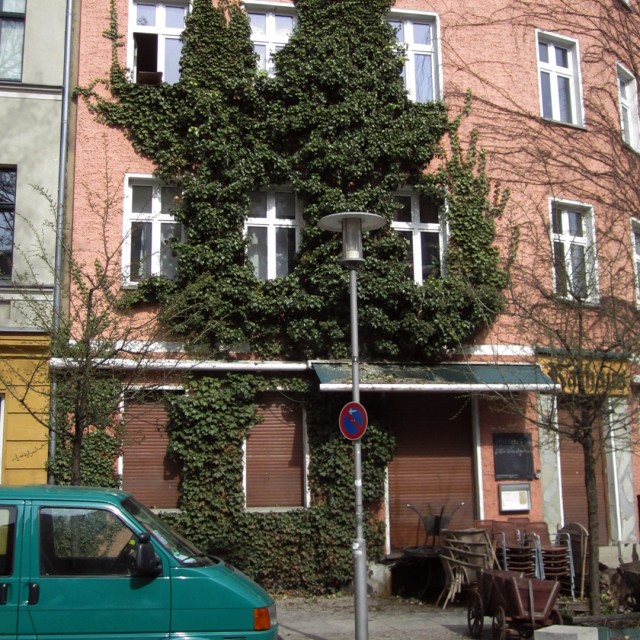Habitat Decline in the City & Country
A recent article in the Guardian discusses the decline in starling populations in England. According to the article, starlings migrate every year from Scandinavia to meet and mate in the English countryside, but because of the impact of factory farming on insect populations, starlings are disappearing at an alarming rate. The article calls for a more intentional relationship to how the rural landscape is used.
From country to city…
In Chicago, IL, a city we used to live in, starlings were considered an invasive species, brought to the United States by early European settlers (invasive species of a different kind?) they compete with local North American species. A friend of the Mythological Quarter, Mike Wolf, made some drawings of starlings we are sharing here in a poster he made several years ago.
Invasive or not, the birds are part of the larger environmental landscape and need a place to roost, whether they are in their native English countryside or some adopted urban space.
Right now, we are in Berlin. We made a spring migration of our own and are staying in the Lichtenberg neighborhood, a part of former East Germany, for a month. While we are here we have been taking walks around our neighborhood trying to get to know the place a little. One feature of our adopted neighborhood is right outside our window: a giant vine filled with birds.
No, “giant vine filled with birds,” is not very specific. The vines are an ivy and the birds might be starlings. They fly out of their home every morning and evening, around dusk, a normal routine bunch of birds.
Documentation of some daily activity:
While starlings in the English countryside are facing habitat loss due to large-scale farming, this unidentified vine and bird flock stand as an important symbol for the potential to create habitat in city spaces.
The clinging vine is certainly a home. It provides a lush shelter above the ground, while it simultaneously integrates with the local architecture – a fluid pairing. The person that planted the original vine was probably not thinking about one day sheltering a flock of birds, but what if they had been. What if we more purposefully planned our city spaces and our rural landscapes to incorporate habitat for the wildlife with which we are already sharing these spaces.
More buildings with vines, insect hotels, bat houses, rooftop wilderness, or roundabouts with bird baths, medians overgrown with bushes – these sorts of additions to our cities could more seamlessly provide shelter for wildlife and increase the biodiversity of the urban landscape. In rural spaces, the challenge is to think around the increased homogenization of the landscape due to industrialized agriculture. How to create habitat and wild spaces within heavily managed factory farms?
We normally think of the city as the place without wildlife and the country as the place to go and absorb “nature,” but in fact the reverse is becoming true as the countryside surrounding urban centers is turned over to large-scale industrial food production. It is a bit chilling to think of a future where there are more birds in bushes on the block than in the field.
Radio Aktiv Sonic Deep Map (2013)

SUPERKILEN – Extreme Neoliberalism Copenhagen Style

Read Brett's essay about the park.
Download our guide:

This is our guide to how-to books from the counterculture of the 60s and 70s. Click to get the download page.
Categories
- Agriculture (11)
- Animal sounds (1)
- Artist parents (19)
- Arts and culture (106)
- Bees (3)
- Book reviews (14)
- Books (18)
- Critical essays (5)
- Daily Photo (5)
- Design (36)
- Dirt (11)
- Environmental activism (43)
- Exhibitions (24)
- Farms (11)
- Forest (7)
- Friday connect (15)
- Growing (42)
- Habitat (38)
- Homesteading (16)
- Interviews (15)
- Kitchen (14)
- Living structure (9)
- MISC (15)
- Mythological (2)
- Neighborhood (83)
- Ocean News (1)
- Our Art Work (21)
- Personal – Design/Art (3)
- Play (2)
- Playground (4)
- Projects (21)
- Public space (53)
- Resilience (13)
- Sea Side (2)
- Sojabønner (2)
- Tofu (8)
- Vermont correspondence (7)
- Water (3)
- Wednesday picture (31)
- Workshop (1)
Video interview:

Watch our interview of SeedBroadcast, a mobile project that is part seed library and part seed-saving-story-collecting machine-recording the stories of seed saving, farming, and food sovereignty work being done around the US.

Download a poster Bonnie made about biodiversity in a vacant lot in the Amager borough of Copenhagen, in collaboration with biologist, Inger Kærgaard, ornithologist, Jørn Lennart Larsen and botanist, Camilla Sønderberg Brok: A BRIEF TAXONOMY OF A LOT

We made and installed a network of bat houses in Urbana, Illinois, to support the local and regional bat population, but also to begin a conversation about re-making the built environment.
READ MORE
BOOK REVIEW:

We write often about artists and art groups that work with putting ‘culture’ back in agriculture. Here is a new favorite: myvillages, a group of three women based in Germany, the Netherlands, and the UK. Read more...

Post Revolutionary Exercises
We really admire the dedicated hard work of Kultivator who seeks to fuse agriculture and art in their work. Click this sentence to get a PDF of their poster collection called "Post Revolutionary Exercises."

Cultural Practices Within And Across
This amazing book networks urban and rural resilience and sustainability projects around the world. Deeply inspiring projects in Romania, Paris, San Francisco, and elsewhere.
• Read our review of the book.
• Buy the book.
• Download the book.










